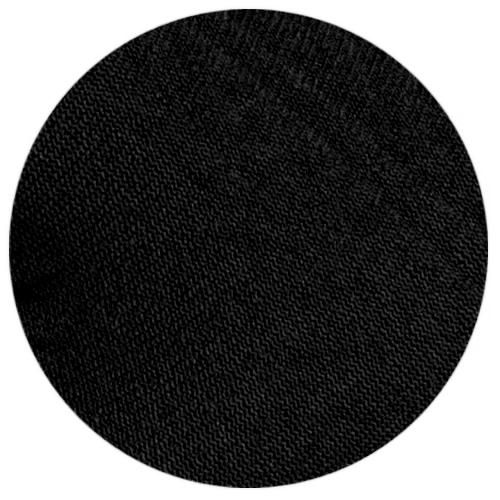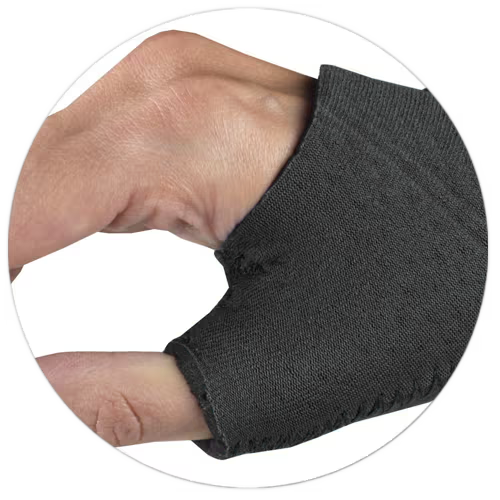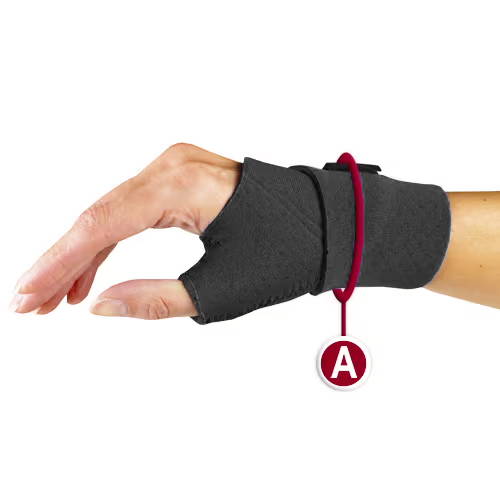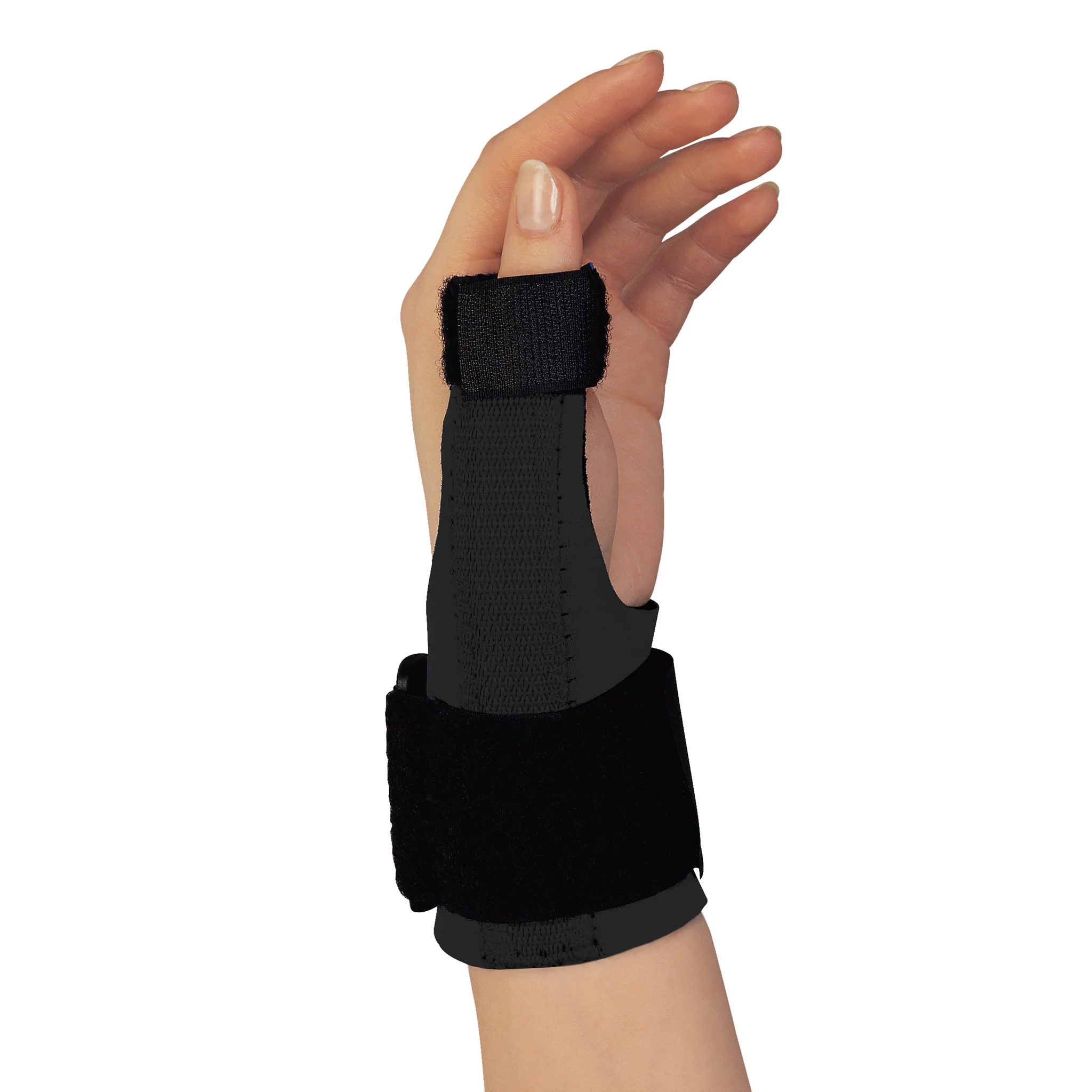0303 / NEOPRENE WRIST-THUMB SUPPORT
The OTC 303 wrist-thumb support retains natural body heat to help soothe aching muscles and maintain flexibility, provide firm, uniform compression to support a weakened joint, and offers moderate protection from bumps and bruises. The high-tech, perforated material “breathes”, allowing perspiration and moisture to escape for extended wearing comfort. Handcrafted construction includes invisible stitching and heat seal seam tape for added comfort and durability. Effective support and value to keep you comfortably active. Excellent for use in athletics and occupational activities.
Indications Listed Below
• Perforated neoprene material is breathable and allows for comfortable long-term wear
• Four-way stretch material provides even compression over the anatomical prominences of the joint
• Holds thumb in opposition to relieve discomfort and prevent reinjury while maintaining full finger dexterity
• Good support for repetitive motion, overuse injuries
• Fits either right or left wrist
• Latex free
Product Features

neoprene material
Perforated neoprene material is breathable and allows for comfortable long-term wear. Four-way stretch material provides even compression over the anatomical prominences of the joint. Latex free.

effective support
Holds thumb in opposition to relieve discomfort and prevent reinjury while maintaining full finger dexterity. Fits either right or left wrist.
How to Measure for and Apply Wrist-Thumb Support
| SIZE | MEASURE AROUND BREAK OF THE WRIST |
|---|---|
| SMALL | 4.75" - 6.0" (12.1 - 15.2 cm) |
| MEDIUM | 6.0" - 8.0" (15.2 - 20.3 cm) |
| LARGE | 8.0" - 10.0" (20.3 - 25.4 cm) |
| X-LARGE | 10.0" - 12.0" (25.4 - 30.5 cm) |
Measuring Instructions
A. Measure around the break of the wrist.
Application Instructions
1. Unfasten hook and loop closure.
2. Insert thumb through thumb hole so that seams are on either side of thumb, and shorter seam is toward the fingers.
3. Grasp closure tab and wrap support around wrist and fasten.

Medical Applications
Review the accompanying chart to determine the product that best suits your needs. On the left, you will find a variety of injuries that OTC products are specifically designed to treat and prevent. On the top, you will find the product numbers of all OTC Wrist Products. If a red box is present where the column and row intersect, your injury or condition is treated/prevented by the associated product.
| 0128 | 0303 | 0304 | 0305 | 2072 | 2074 | 2075 | 2081 | 2082 | 2083 | 2086 | 2087 | 2088 | 2351 | 2360 | 2361 | 2362 | 2364 | 2365 | 2383 | 2382 | 2386 | 2387 | 2389 | 2418 | 2438 | |
|---|---|---|---|---|---|---|---|---|---|---|---|---|---|---|---|---|---|---|---|---|---|---|---|---|---|---|
| Advanced CTS | ||||||||||||||||||||||||||
| Arthritis (Basal Joint) | ||||||||||||||||||||||||||
| Arthritis (Fingers, Hands) | ||||||||||||||||||||||||||
| Arthritic Pain | ||||||||||||||||||||||||||
| Basal Joint Hyperextension | ||||||||||||||||||||||||||
| Broken Fingers or Knuckles | ||||||||||||||||||||||||||
| Carpal Tunnel Syndrome (CTS) | ||||||||||||||||||||||||||
| Cumulative Trauma Disorders | ||||||||||||||||||||||||||
| Degenerative Joint Disease | ||||||||||||||||||||||||||
| DeQuervain's Tendonitis | ||||||||||||||||||||||||||
| Gamekeeper's Thumb | ||||||||||||||||||||||||||
| Hyperextension | ||||||||||||||||||||||||||
| Ligament Strains | ||||||||||||||||||||||||||
| MCP Joint Sprains, Strains | ||||||||||||||||||||||||||
| Metacarpal Fracture | ||||||||||||||||||||||||||
| Mild Sprains, Strains | ||||||||||||||||||||||||||
| Moderate Sprains, Strains | ||||||||||||||||||||||||||
| Osteoarthritis | ||||||||||||||||||||||||||
| Post-cast | ||||||||||||||||||||||||||
| Post-operative (Hand) | ||||||||||||||||||||||||||
| Repetitive Stress Injury | ||||||||||||||||||||||||||
| Tendonitis | ||||||||||||||||||||||||||
| Trigger Finger |
SPRAIN AND STRAIN CONDITIONS
These affect the connective tissues around the joints. Sprains are injuries to ligaments.The injury can be considered mild (slight stretching), moderate (partial tear), or severe(complete tearing). One or more ligaments can be injured in a sprain. The severity of the strain will depend on the extent of injury to a single ligament (whether the tear is partial or complete) and the number of ligaments involved.
Wrist supports or braces are applied to support and compress the soft tissues, helping to reduce swelling and relieve pain. They also provide varying degrees of stability to help prevent re-injury. Wrist braces are also an excellent post-operative tool to speed recovery and help maintain necessary activities during recuperation.
The conditions shown below may not be treated by the product listed on this page. Please view the above Medical Applications Chart to determine what conditions this page's associated product treats.
Mild strains
A mild strain can occur for a number of reasons, but is most often caused by a person’s weight being applied to a wrist that is at an unnatural angle - eversion or inversion - with the ligament or ligament group being stretched or even torn.
moderate & Severe sprains
A moderate sprain is slight tearing of a ligament or ligament group, while a severe sprain will always be a complete, and usually among a ligament group. Sprains are deemed mild, moderate or severe based on the extent of injury and the number of ligaments.
Carpal Tunnel Syndrome
Carpal tunnel syndrome – or CTS – is repetitive-motion trauma of the hand and wrist. Symptoms of this painful disorder include numbness, tingling, weakness and aching of the hand and arm. The pain of carpal tunnel syndrome arises when the median nerve that passes through the wrist bones – or carpal tunnel – becomes pinched by swollen tendons and membranes. Damage to the nerve is cumulative and, if gone untreated for too long, can result in permanent loss of sensory and motor abilities.
WRIST AND FOREARM ANATOMY
Wrist & Hand
A. Median Nerve
B. Radial Bursa
C. Ulnar Nerve
D. Transverse Carpal Ligament
FOREARM
A. Ulna Bone
B. Radius Bone

